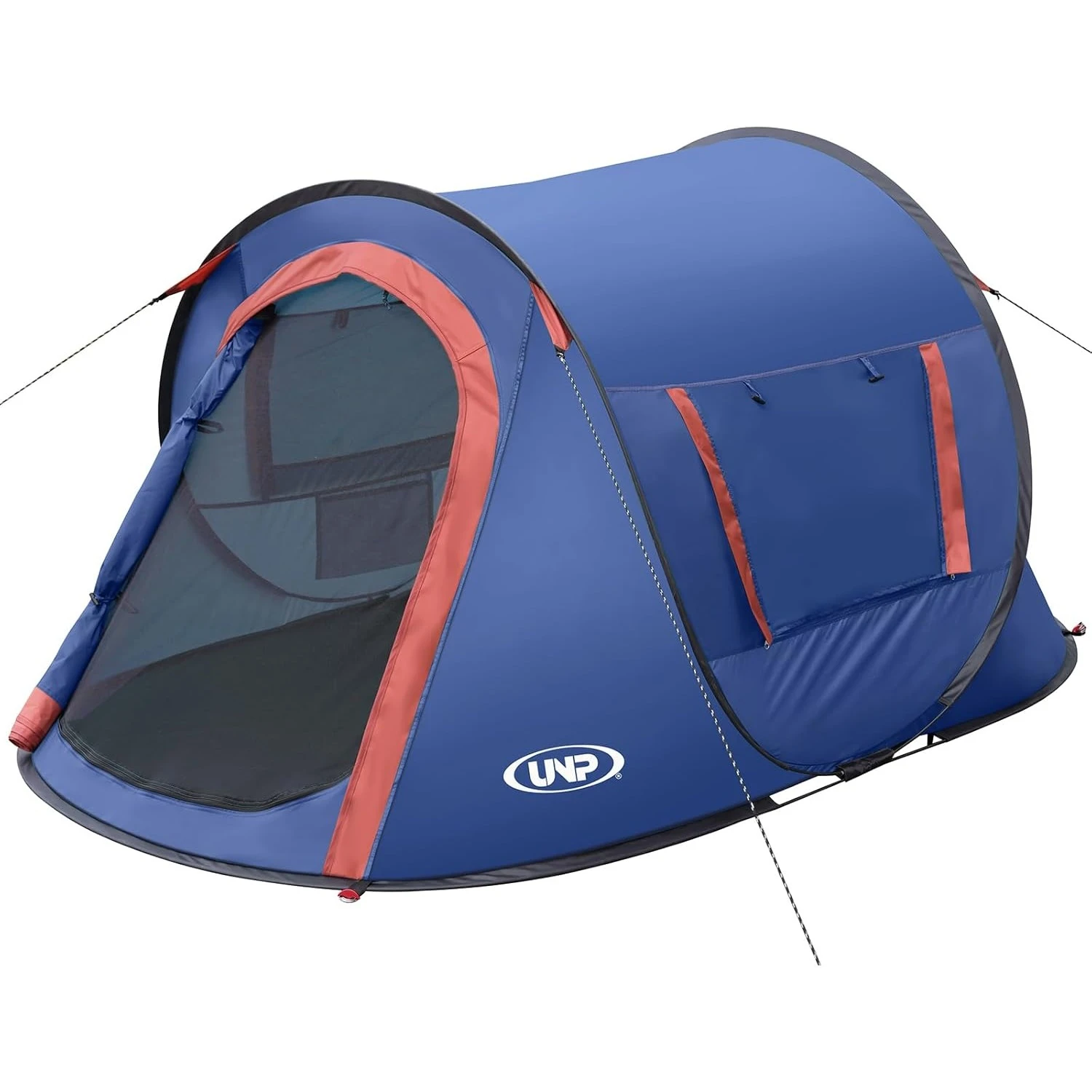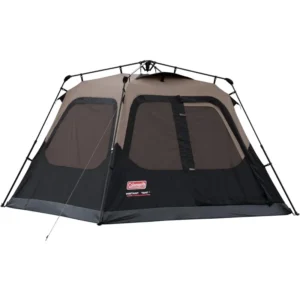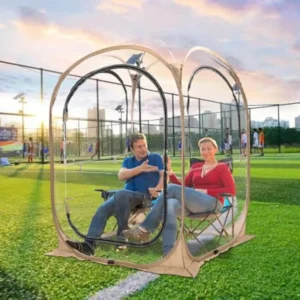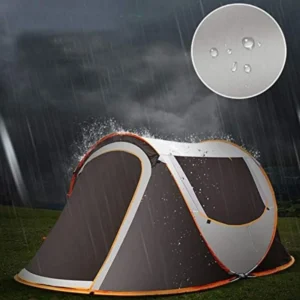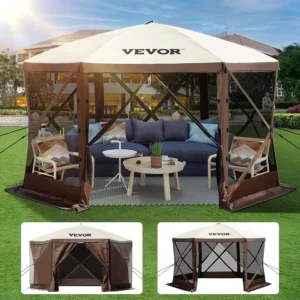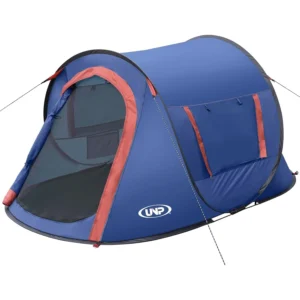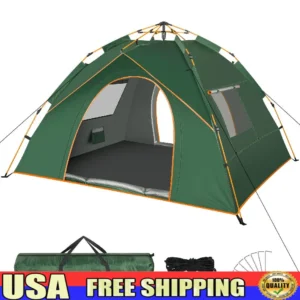Introduction: Effortless Adventures for Two
Have you ever arrived at a campsite as daylight fades, only to spend the next 30 minutes wrestling with tent poles and instructions while your partner holds a flashlight? Or perhaps you’ve postponed weekend getaways simply because setting up camp feels like too much work? For many couples and camping pairs, these frustrating scenarios often overshadow the joy of outdoor adventures.
Pop-up tents offer a refreshing alternative to this common camping headache. These innovative shelters utilize pre-assembled frame systems that literally “pop” into shape within seconds of unpacking. Unlike traditional tents requiring manual assembly of poles, rainflies, and careful staking, pop-up models transform from compact discs into full-sized shelters with minimal effort.
What makes these tents particularly advantageous for two-person adventures is their perfect balance of simplicity, size, and functionality. Based on extensive field testing across various environments, we’ve found that these shelters excel in situations where convenience matters most for pairs of campers.
Throughout this guide, we’ll explore the key benefits that make pop-up tents an excellent choice for duos seeking hassle-free outdoor experiences:
- Lightning-fast setup and takedown that maximizes quality time together
- Superior portability and compact storage for easier travel
- Thoughtful design features specifically benefiting two occupants
- Convenience factors that enhance spontaneous adventures
- Cost-effective options that don’t sacrifice essential functionality
As outdoor enthusiasts ourselves, we understand how shelter options for two campers can significantly impact your overall experience. Whether you’re planning a beach day, festival weekend, or casual camping trip, modern 2-person pop-up tents offer distinct advantages worth considering for your next adventure.
Lightning-Fast Setup & Takedown: More Time Together, Less Time Struggling
Perhaps the most compelling advantage of pop-up tents is their remarkably simple deployment. While traditional two-person tents typically require 10-20 minutes of assembly (sometimes longer for beginners or in challenging conditions), quality pop-up models transform from packed to fully erected in mere seconds—often under 60 seconds total.
This rapid transformation happens thanks to specialized pre-assembled frame systems. Unlike conventional tents where you must connect poles and thread them through fabric sleeves, pop-up models feature flexible frames permanently integrated into the tent fabric. When released from their carrying case, these frames naturally spring into their intended shape, creating an instant shelter.
For couples and pairs, this efficiency translates to tangible benefits:
“We arrived at our campsite after a three-hour drive, just as the sun was setting,” shares one regular user. “Instead of rushing to set up before dark, our pop-up tent was ready in seconds. We actually got to enjoy watching the sunset together instead of struggling with equipment.”
The psychological impact shouldn’t be underestimated either. By eliminating the often frustrating setup process, pop-up tents remove a common source of camping-related stress and potential disagreements. Partners can divide other camp tasks equally without getting bogged down in complex tent assembly.
The takedown process, while requiring a bit more technique, is similarly efficient once mastered. Most quality two-person pop-up tents can be collapsed and packed away in 2-3 minutes. This means less time breaking camp and more time enjoying your morning together or getting an early start on the day’s adventures.
For weekend travelers or those making multiple stops during a trip, this time-saving aspect becomes even more valuable. Instead of dreading the repeated setup and takedown process, campers can focus on what truly matters—experiences together in the outdoors. The principles of fast setup tents create opportunities for more spontaneous adventures without the typical hassles of traditional camping.
When choosing among various instant camping tent options, this setup speed stands as perhaps the most transformative feature, fundamentally changing how couples approach outdoor overnight experiences.
Unmatched Portability & Compact Storage: Travel Lighter Together
Beyond setup convenience, pop-up tents offer significant advantages in portability and storage—crucial factors when traveling as a pair. Most quality two-person pop-up tents weigh between 4-7 pounds (1.8-3.2 kg), making them notably lighter than many traditional counterparts of similar size that often weigh 7-10 pounds (3.2-4.5 kg) or more.
This lighter weight means easier distribution of camping gear between two people. When hiking to a campsite or transporting equipment from a parking area, every pound matters. The reduced weight allows couples to either carry more comfort items or simply enjoy less physically demanding transport.
The packed shape of pop-up tents offers unique advantages as well. While traditional tents typically fold into long, cylindrical bags, pop-up models compress into flat, disc-shaped packages approximately 24-30 inches (61-76 cm) in diameter and 2-3 inches (5-8 cm) thick. This flat profile fits easily into vehicle trunks, often sliding neatly behind seats or atop other gear without consuming excessive space.
“We drive a compact car, and before switching to a pop-up tent, we struggled to fit all our camping gear for weekend trips,” explains one camping enthusiast. “Now our tent takes up minimal space, allowing room for comfort items we previously had to leave behind.”
The storage benefits extend beyond travel considerations. For urban dwellers or those with limited storage space, lightweight pop-up tent options can be tucked into closets, under beds, or in storage compartments that wouldn’t accommodate bulkier traditional tent packages. This makes pop-up tents particularly appealing for apartment-dwelling couples who lack dedicated gear storage areas.
For campers who frequently move between sites during a single trip, the quick packing ability and compact nature of these tents eliminate a significant logistical challenge. Rather than dedicating substantial time and energy to breaking down and repacking a conventional tent, travelers can quickly transition between locations with minimal effort.
Understanding proper mastering tent packing tips is essential for maximizing these portability benefits, ensuring your tent remains compact and protected between uses. With proper technique, most users can master the folding process after just a few practice attempts.
Designed with Duos in Mind: Comfort and Practicality for Two
Pop-up tents designed for two occupants offer thoughtful features specifically beneficial for pairs. While compact when packed, quality two-person models typically provide 30-35 square feet (2.8-3.2 square meters) of floor space—sufficient room for two standard sleeping pads placed side by side. Understanding what size tent is good for 2 people helps ensure you select a model that balances portability with adequate personal space.
The instant structure of these tents creates immediate personal territory—a psychological benefit after a long day of travel or outdoor activities. Rather than waiting to establish your shelter, you gain instant access to a private space for changing clothes, organizing gear, or simply relaxing together.
Interior features in quality models are specifically designed with two occupants in mind:
- Dual-side storage pockets allow each person to keep essentials (headlamps, phones, small personal items) readily accessible without encroaching on their partner’s space
- Overhead gear lofts provide additional storage for shared items while maximizing limited floor space
- Interior loops for hanging small lights create ambient evening illumination
Ventilation becomes particularly important when two people occupy a relatively compact shelter. Body heat and respiration from two sleepers can create significant moisture accumulation without proper airflow. Superior pop-up tent designs address this with:
- Multiple mesh panels positioned to create cross-ventilation
- Adjustable vents that can be operated from inside the tent
- Partial or full-mesh doors that maintain airflow while preserving privacy
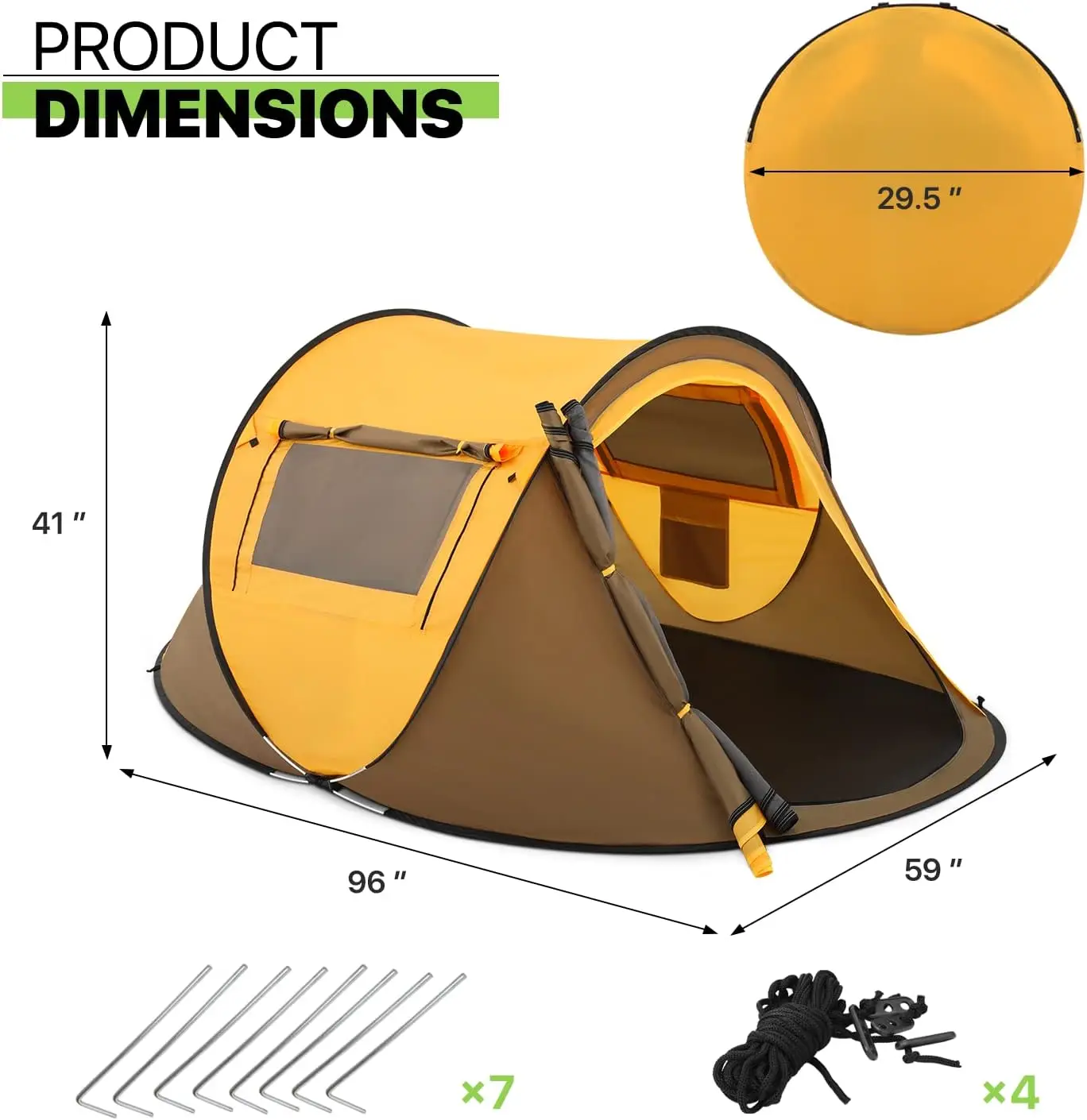
Entry and exit design deserves special attention when selecting a two-person model. Single-door designs, while functional, require one person to climb over the other for nighttime bathroom trips. Dual-door models eliminate this disturbance, allowing each occupant independent access—a seemingly small feature that significantly enhances comfort during multi-night stays.
Many models also include small vestibule areas outside the main sleeping chamber where shoes and other small items can be stored without bringing dirt or moisture into the main living space. This thoughtful separation helps maintain cleanliness within the tent, particularly important when sharing limited square footage.
The Convenience Factor: Simplifying Your Shared Outdoor Experiences
The convenience advantages of pop-up tents extend well beyond the initial setup process, enhancing multiple aspects of two-person camping experiences. This convenience factor manifests in several practical ways:
Spontaneity becomes significantly more achievable when complex equipment setup doesn’t factor into your plans. Imagine deciding Friday afternoon to escape for a weekend getaway—with a pop-up tent, you can pack quickly and depart without extensive preparation or equipment concerns. This reduced planning barrier encourages more frequent outdoor adventures.
For festival attendees, the advantages are particularly notable. Navigate crowded grounds, locate your assigned spot, and establish your shelter in seconds while others spend valuable time assembling conventional tents. When thousands of people simultaneously seek camping space, this efficiency provides a meaningful advantage in securing optimal locations.
The minimal learning curve benefits couples where one partner may have less outdoor experience. Unlike traditional tents with their specific assembly sequences and techniques, pop-up models require almost no technical knowledge to deploy successfully. This accessibility helps balance participation in camp setup tasks regardless of prior camping experience.
“My partner was always intimidated by the camping setup process,” shares one tent owner. “Since switching to a pop-up tent, we’ve camped more frequently because the experience feels more accessible and enjoyable for both of us.”
Understanding how instant tents work for couples reveals why these shelters excel in situations where time and effort conservation matters most. The simplified process reduces potential friction points during setup and takedown—often high-stress moments when camping—allowing partners to focus on enjoying their surroundings and each other’s company.
For those new to outdoor adventures, pop-up tents remove a significant barrier to entry. The technical challenges of traditional tent assembly can discourage beginners from pursuing camping altogether. By eliminating this complexity, pop-up designs make outdoor experiences more approachable for all experience levels.
Easy Setup Camping Tent, Instant Camping Tent
Instant Cabin Tent Double Layer Canvas 1-Minute Setup Spacious Family Camping Shelter with Air Vents$308.10 Select options This product has multiple variants. The options may be chosen on the product pagePop Up Dome Tent, Waterproof Pop Up Tent
$218.89 Select options This product has multiple variants. The options may be chosen on the product page- $633.01 Select options This product has multiple variants. The options may be chosen on the product page
Easy Setup Camping Tent, Instant Camping Tent, Lightweight Pop Up Tent, Pop Up Dome Tent
$252.30 Select options This product has multiple variants. The options may be chosen on the product pageDome Camping Tent, Easy Setup Camping Tent, Pop Up Dome Tent, Waterproof Pop Up Tent
$162.68 Select options This product has multiple variants. The options may be chosen on the product page
Cost-Effectiveness: An Affordable Option for Pairs
Pop-up tents for two people typically represent an excellent value proposition, especially for occasional campers and weekend adventurers. Quality two-person models generally range from $80-150, compared to traditional tents of similar quality that often start at $120 and quickly escalate to $200+ for comparable features.
This pricing advantage becomes particularly relevant when considering actual usage patterns. For weekend campers using their tent 5-10 nights annually, the convenience benefits easily justify the investment, especially when the initial purchase price may actually be lower than comparable traditional options.
The value calculation extends further when comparing camping to other accommodation options. A $100 pop-up tent used for just two weekend trips represents significant savings compared to hotel or vacation rental costs. Even with additional camping fees, the economics strongly favor tent camping for budget-conscious travelers.
For occasional campers, the ease-of-use factor contributes significantly to the overall value proposition. By removing setup frustration, these tents encourage more frequent use, effectively lowering the per-use cost and increasing return on investment.
It’s important to note that longevity expectations should remain realistic. While premium traditional tents might deliver 7+ years of regular use, most quality pop-up tents provide approximately 2-4 seasons of dependable service with proper care. This shorter lifespan reflects the trade-off between convenience mechanisms and long-term durability.
However, when amortized over expected use, the cost-per-night remains highly competitive. A $120 pop-up tent used for 6 weekends annually (12 nights) over 3 years equals just $3.33 per night—a fraction of alternative accommodation costs.
Key Features to Look for in a 2-Person Pop-Up Tent
When evaluating pop-up tent options for two people, several key features significantly impact performance and satisfaction:
Interior Space Dimensions: While marketed as “two-person,” actual usable space varies considerably between models. Look for tents offering at least 30-35 square feet (2.8-3.2 square meters) of floor space with a center height of 40+ inches (102+ cm). This provides adequate room for two standard sleeping pads plus minimal gear storage.
Waterproofing Standards: Quality pop-up tents should feature rainflies with a minimum hydrostatic head rating of 2000mm for adequate rain protection, with better models offering 3000mm+. The tent floor should provide even greater water resistance (3000mm+) to prevent ground moisture penetration. Many waterproof pop-up tent options incorporate sealed seams and covered zippers for enhanced weather protection.
Frame and Fabric Construction: Fiberglass frames balance flexibility with durability for the pop-up mechanism, while aluminum components offer superior strength-to-weight benefits in premium models. Fabric should be ripstop nylon or polyester with adequate denier (thickness) to resist tearing. Understanding whether pop-up tents are waterproof helps you select appropriate models for your typical conditions.
Ventilation System: Multiple mesh panels positioned for cross-ventilation are essential when two occupants share limited space. Look for adjustable vents that can be operated from inside the tent and protected openings that allow airflow even during light rain.
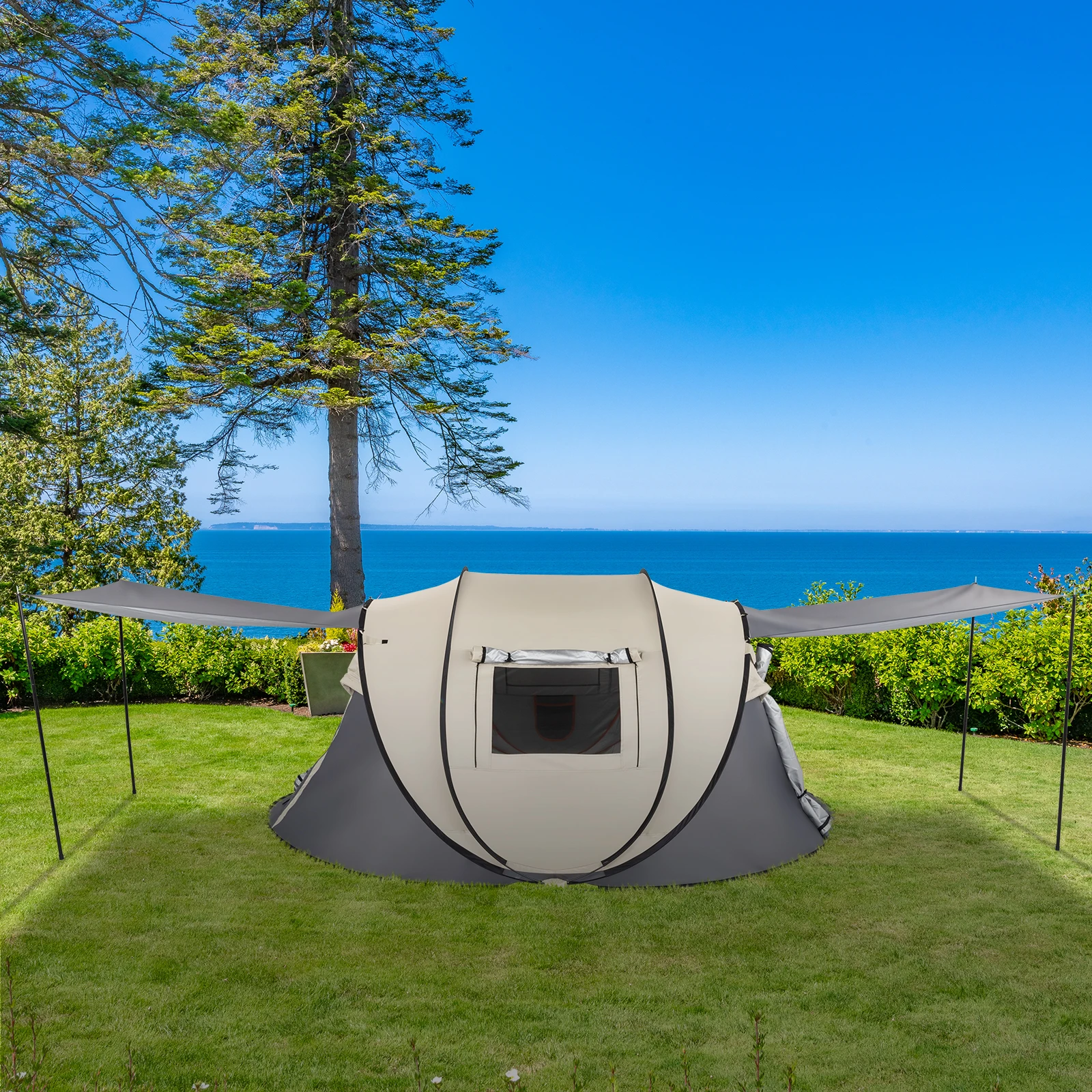
Entry/Exit Configuration: Double-door designs allow each occupant to enter and exit without disturbing their partner—a seemingly small feature that significantly enhances livability during multi-night stays. Zippered mesh inner doors with fabric covers provide versatility for different weather conditions.
Storage Features: Interior pockets along both sides allow each occupant to organize personal items, while overhead gear lofts maximize limited floor space. Small vestibule areas outside the main sleeping chamber provide protected storage for footwear and other items.
Repacking Mechanism: Consider the folding technique required for proper storage. Some models utilize intuitive circular folding patterns, while others require more specific techniques. Factors like grip size and required strength impact how easily different users can manage the process.
Important Considerations Before Choosing a Pop-Up Tent for Two
While pop-up tents offer numerous advantages, understanding their limitations ensures appropriate expectations and usage:
Weather Resistance Limitations: Most pop-up tents perform admirably in mild to moderate conditions but may not match specialized traditional tents in extreme weather. They generally excel in temperatures from 45°F to 85°F (7°C to 29°C) with light to moderate precipitation, but may struggle in sustained heavy rain or strong winds.
Wind Performance: The same structural design enabling rapid setup can create vulnerability in high winds. Most quality pop-up tents remain stable in winds up to 15-20 mph (24-32 km/h), but their typically taller profiles and less rigid pole structures make them more susceptible to strong gusts compared to low-profile traditional tents.
Long-Term Durability: The convenience mechanisms in pop-up tents introduce additional wear points and potential failure areas. Expect 2-3 seasons of regular use before showing wear, compared to 5+ for premium traditional tents. This shorter lifespan reflects the inherent trade-off between convenience and longevity.
Packed Shape Considerations: While efficiently flat when folded, the circular disc shape of packed pop-up tents can be awkward to attach to backpacks or transport over long distances by foot. These tents excel for car camping or short walks to campsites but may prove cumbersome for extended backpacking.
Condensation Management: Two bodies in a small space produce significant moisture through respiration and body heat. Understanding is a 2-person tent actually big enough helps set appropriate expectations for interior space and related condensation challenges. Proper ventilation becomes crucial to prevent moisture accumulation on interior surfaces.
Limited Vestibule Space: Many pop-up models offer minimal exterior covered storage compared to traditional backpacking tents. This limitation affects gear organization options, particularly in wet conditions when keeping equipment protected becomes essential.
Repackaging Learning Curve: While setup proves nearly effortless, the folding technique for proper storage requires practice. Most users need several attempts to master their specific tent’s folding pattern. Practicing at home before your first trip prevents frustration in the field.
Are the Advantages of a Pop-Up Tent Right for Your Two-Person Needs?
Determining whether a pop-up tent aligns with your specific requirements involves assessing several factors:
Ideal Users and Scenarios:
* Weekend campers prioritizing convenience over extreme condition performance
* Festival attendees needing quick setup in often crowded environments
* Beach-goers wanting easy sun and wind protection
* Casual campers making frequent stops during road trips
* Beginners seeking accessible entry points to outdoor experiences
* Emergency preparedness kits where rapid deployment might prove valuable
Less Suitable Situations:
* Extended backcountry trips in variable conditions
* High-elevation camping with significant wind exposure
* Winter camping or situations with heavy snow potential
* Ultra-lightweight backpacking where every ounce matters
* Very frequent use where long-term durability becomes paramount
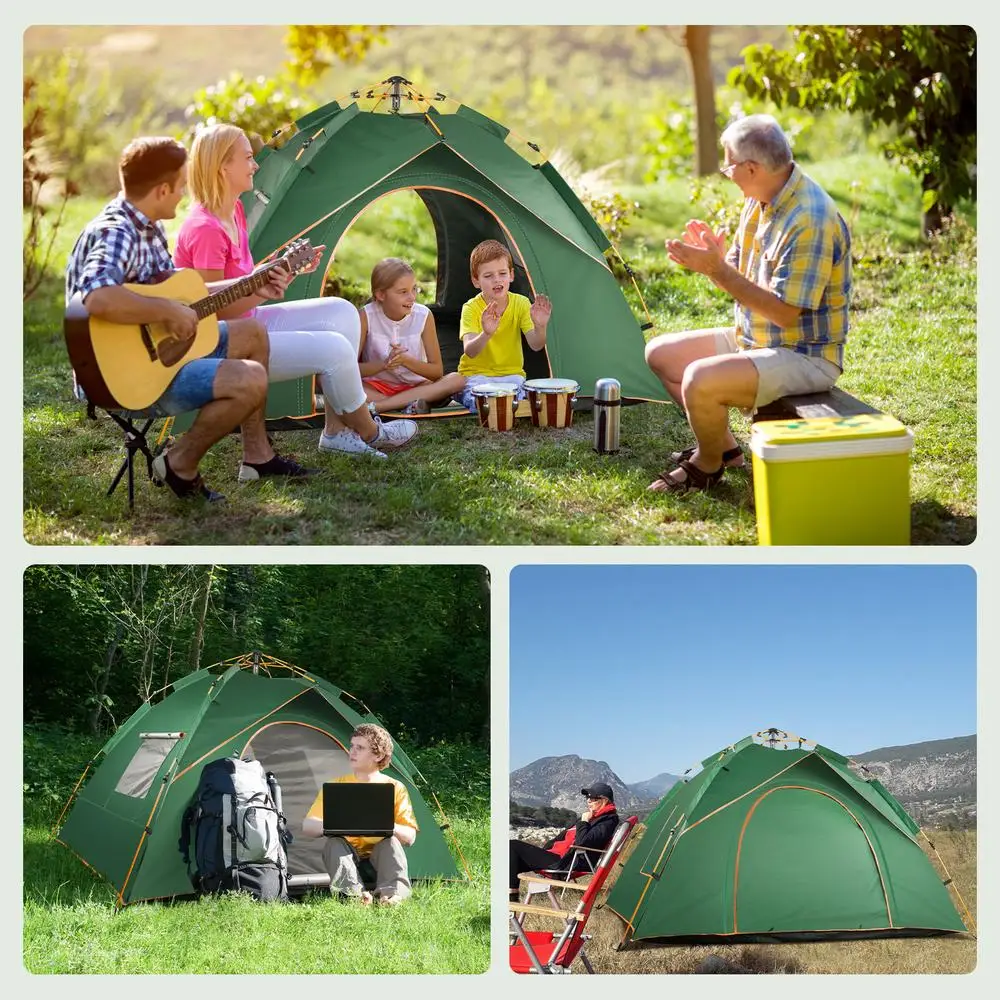
To assess your specific needs, consider:
* What environments will you primarily use the tent in?
* How important is setup convenience versus absolute weather protection?
* Will you typically carry the tent long distances or transport it by vehicle?
* How frequently will you use the tent throughout the year?
* What’s your tolerance for potentially replacing gear more frequently?
For many couples and pairs, the advantages of pop-up tents align perfectly with their camping patterns. The convenience benefits significantly enhance weekend adventures, spontaneous getaways, and multi-stop journeys. Understanding the various compact shelter options for two helps you select equipment that best matches your specific outdoor activities.
If you frequently camp in mild conditions, prioritize quick setup and takedown, and typically transport your gear by vehicle, a quality pop-up dome tent likely represents an excellent choice. If, however, you regularly face extreme conditions or backpack long distances, traditional tents may better serve your needs despite requiring more assembly time.
Conclusion: Embrace Simpler, Faster Camping Adventures Together
Pop-up tents transform the camping experience for pairs by eliminating common friction points that often diminish outdoor enjoyment. From setup in seconds to effortless transport and storage, these innovative shelters allow couples to focus on what matters most—quality time together in natural settings.
The advantages extend throughout the camping experience: arriving at your destination and establishing shelter without stress; spending more time enjoying activities rather than managing equipment; departing quickly without complex disassembly processes; and storing your gear efficiently between adventures.
For most recreational campers, the convenience benefits far outweigh the limitations, particularly when used in appropriate conditions. The time and frustration saved translates directly to more quality experiences together outdoors—ultimately the true measure of any camping equipment’s value.
Whether you’re experienced outdoor enthusiasts looking to simplify weekend escapes or newcomers seeking accessible ways to enjoy nature together, pop-up tents offer compelling advantages worth considering for your next adventure.
FAQs About Two-Person Pop-Up Tents
How much interior space do two-person pop-up tents typically offer?
Most two-person pop-up tents provide 30-35 square feet (2.8-3.2 square meters) of floor space, sufficient for two standard sleeping pads placed side by side. Center heights typically range from 40-48 inches (102-122 cm), allowing seated but not standing movement inside.
Are pop-up tents suitable for all weather conditions?
Pop-up tents perform best in mild to moderate weather conditions. Quality models with proper rainflies handle light to moderate rainfall effectively, but they may not match specialized traditional tents during sustained heavy precipitation or strong winds (above 20 mph/32 km/h).
Can two adults sleep comfortably in a two-person pop-up tent?
Two average-sized adults can sleep adequately in most two-person pop-up tents, though with minimal extra space. For enhanced comfort, especially for larger individuals or those desiring additional room for gear storage, consider sizing up to a three-person model.
How long do two-person pop-up tents typically last?
With proper care and reasonable use (5-10 nights annually), quality pop-up tents typically provide 2-4 seasons of reliable service. This lifespan is generally shorter than premium traditional tents due to additional wear on the spring-loaded mechanisms and flexible frame components.
Are pop-up tents difficult to repack?
Initial repacking attempts may prove challenging, but most users master their tent’s specific folding pattern after 3-5 practice attempts. Learning to fold your specific tent model before your first trip ensures smoother packing at the campsite. Many manufacturers provide instructional videos to simplify the learning process.
Can pop-up tents be used for backpacking?
While possible for short distances, pop-up tents are not ideal for extensive backpacking. Their disc-shaped packed form is awkward to attach to backpacks, and they generally weigh more than specialized backpacking tents. They excel for car camping or situations requiring only short walks from vehicle to campsite.

